
Your guide to cat scent marking

Lucy Hoile
14 December 2023
Have you ever wondered why your kitty seems to love headbutting you? Perhaps you’ve seen them frequently rubbing themselves up against the furniture?
This isn’t just your cat being sassy – though we know they have bucket loads of that – it’s a behaviour known as scent marking.
Join expert feline behaviourist Lucy Hoile as she jumps into why and how your cat uses scent marking to interact with the world around them.
- Why do cats scent mark?
> What does it mean when a cat headbutts you? - What scent glands do cats have?
> What can cats find out from a scent mark? - How do cats mark their scent?
> How cats scent mark inside the home
> How cats scent mark outside the home - Cats scent marking due to anxiety
- How to stop cats from scent marking
> How to remove cat scent marking
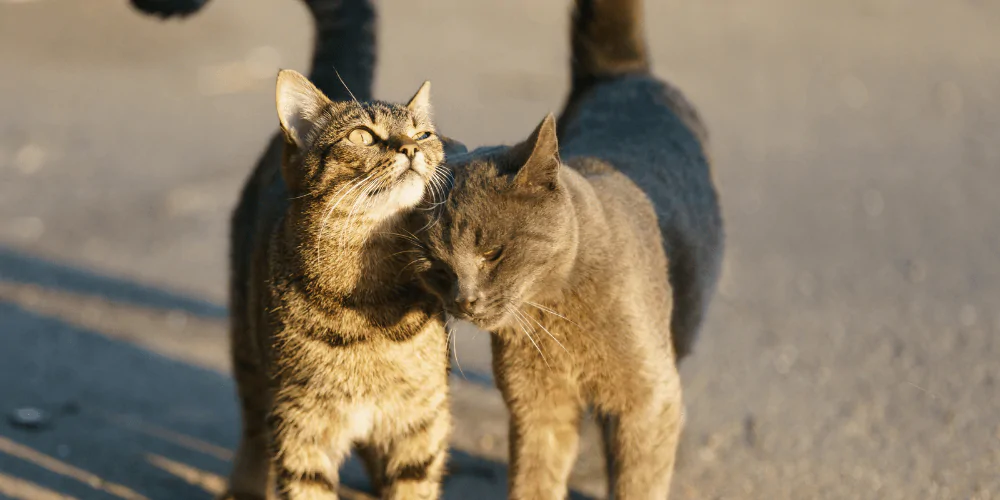
Why do cats scent mark?
Felines are descended from a solitary species and have evolved to avoid risking conflict with other animals, so they prefer long-distance communication.
This means their visual signalling is limited and instead they’ve developed effective communication through scent.
Cats use scent marking to:
- Claim their indoor and outdoor territory – this is a heavy part of a cat’s day-to-day life
- Find a mate – both males and females may spray to find a mate, which is a very common behaviour if a cat isn’t neutered
- Recognise other members of their social group – this is where you see active behaviours like grooming each other, snuggling up, nuzzling, and tail wrapping
Cats can also passively scent mark each other by sleeping in the same beds at different times and sharing litter trays.
> What does it mean when a cat headbutts you?
Headbutting is your cat trying to scent mark you with their face, as well as get attention from you. They may even rub their cheeks and lips along on your fingers.
Cats have several glands in their face:
- Above the eyes, in the area where the fur is thinner
- In their cheeks and around the lips
- On their chin
Facial marking shows your cat sees you as part of their social group and is looking for affection, not trying to hurt you.
It’s very much a positive behaviour, so offer out your hand and rub along these facial areas. And if your cat is enjoying it, they’ll lean into you.
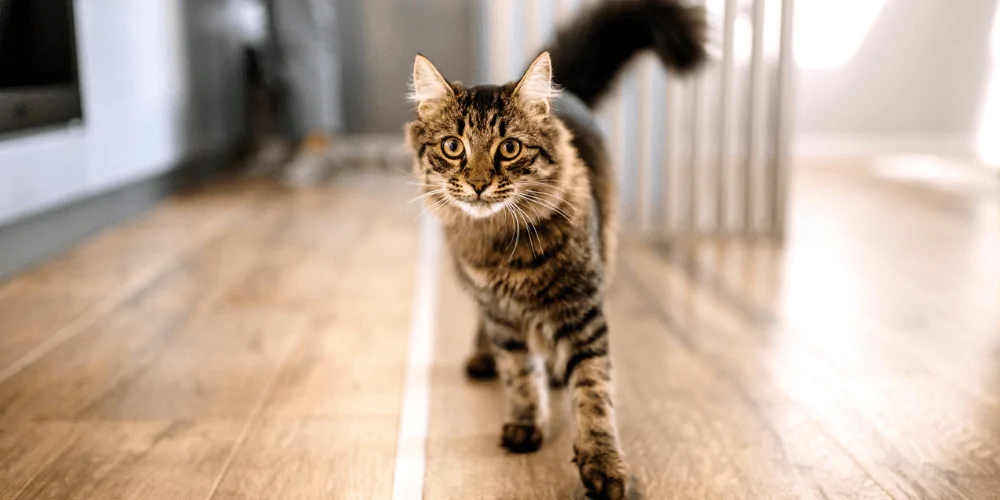
What scent glands do cats have?
A cat’s body is covered in scent glands, giving them plenty of opportunities to leave their mark. These areas include:
- In between the paw pads – scratching to leave behind a scent
- The base of the tail – touching this area can be too overstimulating for your feline
- Tail – passes scent by wrapping around something or someone
- Anal glands – leave pheromones behind in wee and poo
- Nipples (pregnant cats) – release a maternal appeasement pheromone to comfort kittens
> What can cats find out from a scent mark?
A scent mark holds pheromones that contain a bunch of chemicals and smells. These are then picked up by a special organ inside the roof of your cat’s mouth.
Your cat will pull a funny face when using this organ to investigate another cat’s pheromones. The scent mark holds info about a cat’s:
- Neutering status
- Health
- Gender
- Other unique information about the cat
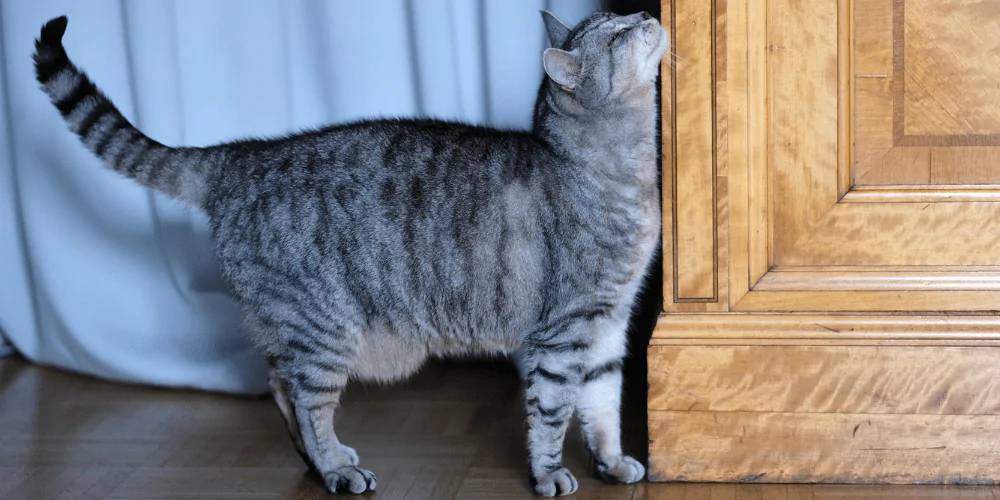
How do cats mark their scent?
Cats mark their core territory (home) in a different way to their wider territory (outside the home).
> How cats scent mark inside the home
Scent marking is done subtly and appropriately inside the home. After all your cat doesn’t want to make a mess of their territory!
This includes:
- Facial marking
- Body rubbing – sleeping somewhere or rolling around on their back
- Scratching – furniture, cat trees, posts, carpet
Having a cat tree is super important as it’s a major and consistent part of your feline’s territory. Always bring in a new cat tree alongside the old one and slowly transition your cat over before removing the old tree.
Other common places that become scent markers in the house include:
- Litter trays
- Beds
- Sofas
> How cats scent mark outside the home
Outside is where your cat needs to step up their game with marking and make it even more intentional.
Scent marking behaviour outside involves:
- Scratching trees, fence posts, and other enticing areas – though the scent doesn’t last as long in the elements
- Urine marking – a form of long-distance communication that can be left behind for another cat to investigate without coming directly into contact with each other
- Middening (pooing) – not as common but usually done somewhere very obvious, like the middle of the garden
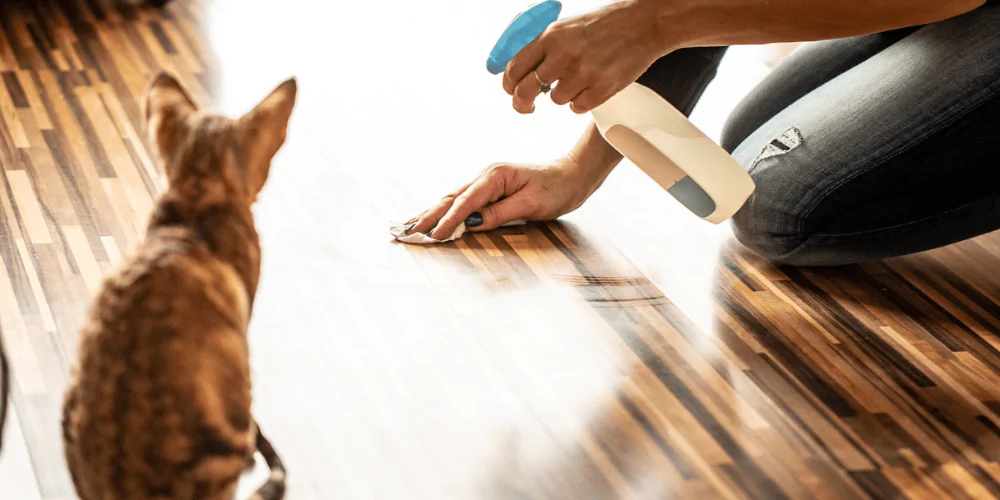
Cats scent marking due to anxiety
Changes to your house’s scent profile or new social problems can cause your cat to feel stressed and anxious. A cat’s tolerance level will also drop if they’re ill. All of these may lead to more scent marking behaviour in their territory.
Remember, cats won’t urine mark inside unless they’re poorly or dealing with stress. So if you notice this happening, take them to the vet first to check for any medical problems.
Examples of environmental stressors include:
- Cleaning or re-painting door frames – a common place for your cat to scent mark
- Replacing the sofa – this is a big one to change as it smells like the family and is a popular place for your cat to sit
- Bigger renovations to the house or garden – the smell of workers, materials, and paint can cause a lot of upheaval
- Neighbours having work done – commotion around the home can also affect your feline
Social stressors can also cause increased marking. These could be:
- A new cat joining the family
- Cats within the family falling out with each other
- Humans not treating your cat kindly, creating a bad relationship
- Other cats spraying entryways – unknown cats spraying cat flaps and doors can be a sign that they’re trying to claim the territory
The places where your cat is marking gives you clues as to what’s bothering them.
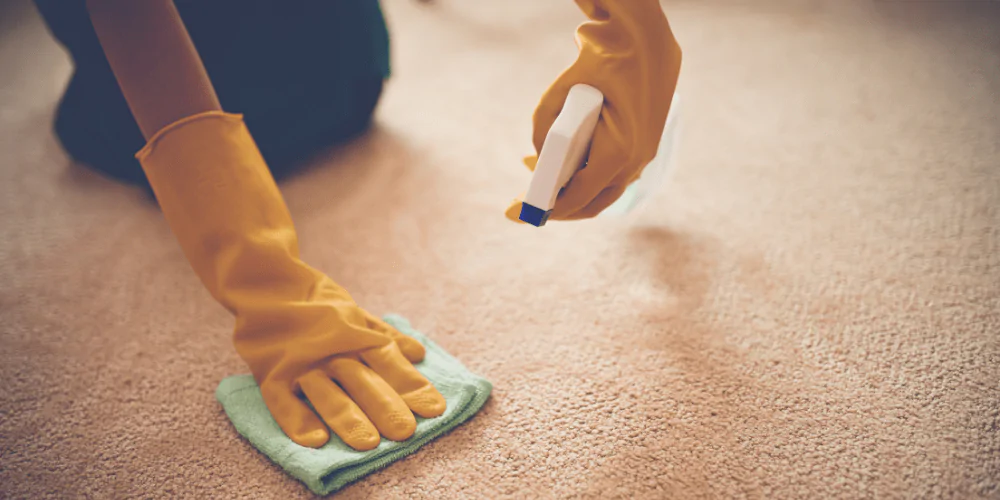
How to stop cats from scent marking
Facial marking is a natural behaviour – so don’t discourage it!
Remember to be careful of:
- Doing heavy cleaning in areas they mark with their face
- Using strong smells in the home, such as spray air fresheners and reed diffusers
- Wearing strong perfume – it can be overwhelming and affect their scent profile
To manage unwanted scratch marking, place scratch posts and cat trees in places they want to mark. For example, the sofa or stairs.
If your cat has started urine marking:
- Make sure they’re not experiencing any environmental or social stresses
- Keep their litter tray clean and make sure they can reach it – it might be in an awkward spot or your cat could be getting ambushed
- Go around the house and look it at from your cat’s point of view – see if there’s anything that could be making them anxious
Punishing your cat for urine marking won’t make them stop the behaviour. Never:
- Spray them with water or throw things
- Use an ultrasonic deterrent
- Leave strong-smelling things like orange peels or vinegar around the home
You’ll simply be adding to their stress and dealing with the symptoms, not the cause. Reach out to a qualified behaviourist if you’re worried about urine marking.
> How to remove cat scent marking
Cats sometimes target places with absorbent material so the smell will linger.
For soft surfaces, like a sofa or carpet:
- Blot the area with a paper towel
- Use a biological product that will break down the enzymes in the wee
- Spray with surgical spirit (test the surface first)
- Stay away from cleaning products that have bleach or ammonia as this can encourage your cat to go back and mark the area
If they’ve urine marked over and over again on furniture, you may just need to completely replace it. This is also true if the urine has seeped into floorboards or carpet underlay.
That’s why it’s important to deal with urine marking as soon as you notice it.
Show your cat some reciprocal love and protect them throughout life’s adventures with Petsure cat insurance.


